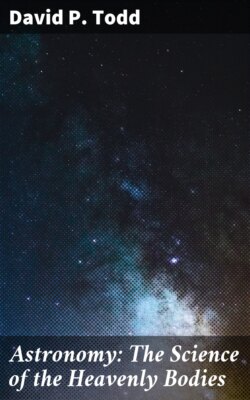Читать книгу Astronomy: The Science of the Heavenly Bodies - David P. Todd - Страница 15
На сайте Литреса книга снята с продажи.
CHAPTER XI
GALILEO, THE GREAT EXPERIMENTER
ОглавлениеTable of Contents
The fifteenth and sixteenth centuries, containing the lives and work of Copernicus, Tycho, Galileo, Kepler, Huygens, Halley, and Newton, were a veritable Golden Age of astronomy. All these men were truly great and original investigators.
None had a career more picturesque and popular than did Galileo. Born a few years earlier and dying a few years later than Kepler, the work of each of these two great astronomers was wholly independent of the other and in entirely different fields. Kepler was discovering the laws of planetary motion, while Galileo was laying the secure foundations of the new science of dynamics, in particular the laws of falling bodies, that was necessary before Kepler's laws could be fully understood. When only eighteen Galileo's keen power of observation led to his discovery of the laws of pendulum motion, suggested by the oscillation to and fro of a lamp in the cathedral of Pisa.
The world-famous leaning tower of this place, where he was born, served as a physical laboratory from the top of which he dropped various objects, and thus was led to formulate the laws of falling bodies. He proved that Aristotle was all wrong in saying that a heavy body must fall swifter in proportion to its weight than a lighter one. These and other discoveries rendered him unpopular with his associates, who christened him the "Wrangler."
The new system of Copernicus appealed to him; and when he, first of all men, turned a telescope on the heavenly bodies, there was Venus with phases like those of the moon, and Jupiter with satellites traveling about it—a Copernican system in miniature. Nothing could have happened that would have provided a better demonstration of the truth of the new system and the falsity of the old. His marvelous discoveries caused the greatest excitement—consternation even, among the anti-Copernicans. Galileo published the "Sidereus Nuncius," with many observations and drawings of the moon, which he showed to be a body not wholly dissimilar to the earth: this, too, was obviously of great moment in corroboration of the Copernican order and in contradiction to the Ptolemaic, which maintained sharp lines of demarcation between things terrestrial and things celestial.
His telescopes, small as they were, revealed to him anomalous appearances on both sides of the planet Saturn which he called ansæ, or handles. But their subsequent disappearance was unaccountable to him, and later observers, who kept on guessing ineffectively till Huygens, nearly a half century after, showed that the true nature of the appendage was a ring. Spots on the sun were frequently observed by Galileo and led to bitter controversies. He proved, however, that they were objects on the sun itself, not outside it, and by noticing their repeated transits across the sun's disk, he showed that the sun turned round on his axis in a little less than a month—another analogy to the like motion of the earth on the Copernican plan.
Galileo's appointment in 1610 as "First Philosopher and Mathematician" to the Grand Duke of Tuscany gave him abundant time for the pursuit of original investigations and the preparation of books and pamphlets. His first visit to Rome the year following was the occasion of a reception with great honor by many cardinals and others of high rank. His lack of sympathy with others whose views differed from his, and his naturally controversial spirit, had begun to lead him headlong into controversies with the Jesuits and the church, which culminated in his censure by the authorities of the church and persecution by the Inquisition.
In 1618 three comets appeared, and Galileo was again in controversial hot water with the Jesuits. But it led to the publication five years later of "Il Saggiatore" (The Assayer), of no great scientific value, but only a brilliant bit of controversial literature dedicated to the newly elevated Pope, Urban VIII. Later he wrote through several years a great treatise, more or less controversial in character, entitled a "Dialogue on the Two Chief Systems of the World" between three speakers, and extending through four successive days. Simplicio argues for the Aristotelians, Salviati for the Copernicans, while Sagredo does his best to be neutral. It will always be a very readable book, and we are fortunate to have a recent translation by Professor Crew of Evanston.
Here we find the first suggestion of the modern method of getting stellar parallaxes, the relative parallax, that is, of two stars in the same field—a method not put into service till Bessel's time, two centuries later. But the most important chapters of the "Dialogue" deal with Galileo's investigations of the laws of motion of bodies in general, which he applied to the problem of the earth's motion. In this he really anticipated Newton in the first of his three laws of motion, and in a subsequent work, dealing with the theory of projectiles, he reaches substantially the results of Newton's second law of motion, although he gave no general statement of the principle. Nevertheless, in the epoch where his life was lived and his work done, his telescopic discoveries, combined with his dynamic researches in untrodden fields, resulted in the complete and final overthrow of the ancient system of error, and the secure establishment of the Copernican system beyond further question and discussion. Only then could the science of astronomy proceed unhampered to the fullest development by the master minds of succeeding centuries.
